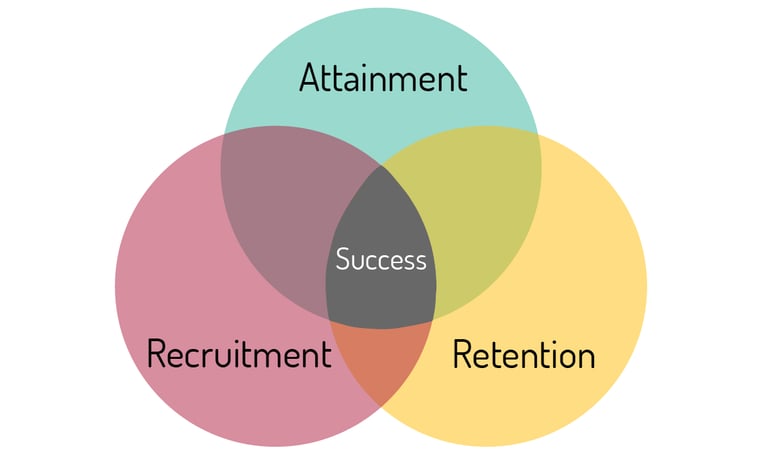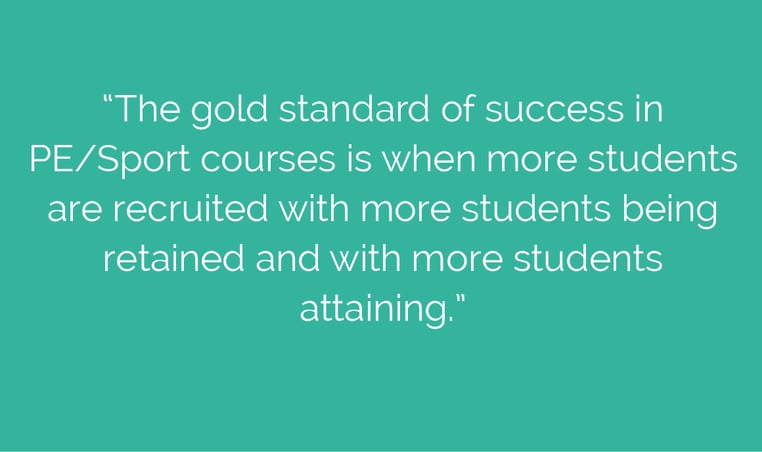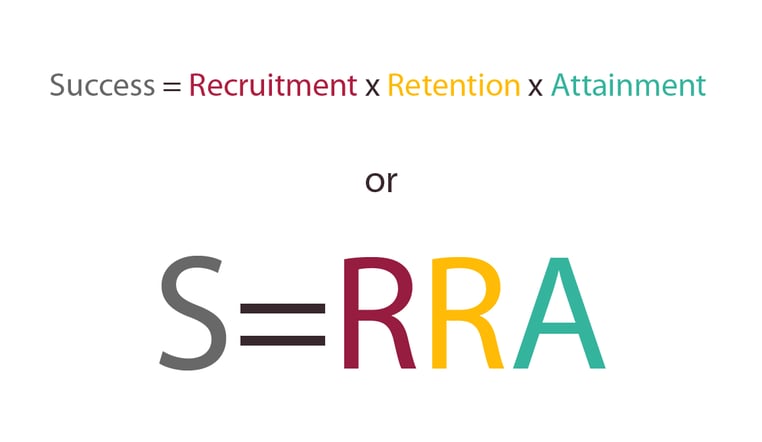Defining Success in PE and Sport Courses - Recruit, Retain, Attain (Part 1)
To kick this week’s post off, I would like to pose you a few questions:
Q: How do you know?
Q: What are your Key Performance Indicators (KPIs) for your PE/Sport course?
Q: Why exactly do you use these KPIs?
Q: Are your KPIs designed to be monitored during your course or only after the course has ended?
Q: Based on the previous question: Why?
So, this will probably provoke a few initial thoughts and ideas and I want to expand this to stress what I believe are the weaknesses of the ways in which many (certainly not all) PE/Sport courses and judged:
- In my opinion, many PE/Sport courses rely too heavily on historic (otherwise known as post-game) data.
- In my opinion, many PE/Sport courses under-value recruitment trends as indicators of success.
- In my opinion, many PE/Sport courses under-value retention statistics as indicators of success.
- In my opinion, many PE/Sport courses over-value attainment data compared to recruitment and retention data.
So, in summary, I believe that there are three primary indicators of success and they are:

Another way to express this idea would be:

If any part of this model is in decline over time, a course cannot be considered successful. For example, a course that has excellent attainment statistics but “culls” (does not retain) students who threaten attainment statistics is, categorically, not successful. Likewise, a course that is growing in numbers (recruitment) but at the cost of attainment is not succeeding.
Therefore, I am arguing that:

Now, it would be inadvisable for me to try to cover every single implication of this suggestion in a single blog post, so I would like readers to consider this post to be an introduction to a series of posts on success in PE/Sport courses. To support this introduction, I aim to write a brief presentation of each of the elements of this suggestion, which will then be broadened in future posts.
Recruitment
The indicators of strong recruitment are quite simple. Strong recruitment can be measured in two ways:
- Change in course numbers over three years (optimal way to measure recruitment trends)
- Change in course numbers per year (optimal way to calculate recruitment in a particular year but problematic because of temporary factors that can influence data)
Recruitment can also be projected in advance of confirmed course numbers. This will be done in most centres with GCSE option choices or with intended A-level course combinations, etc. However, in very few centres I have worked in/with are these projected cohorts then actively guided as to why they should take up this course.
Let’s take the example of a group of Year 9 students who have indicated a preference for GCSE PE. Let’s say we have a list of 40 students making two well-sized teaching groups. What happens when a course manager receives this number? In my experience, too little is done to manage this success indicator. If 40 students have indicated a preference for GCSE PE, this leaves two very important groups:
- 40 students with the intent of studying PE but with this preference not yet confirmed.
- The year cohort minus 40 students who do not have the intention of studying GCSE PE but may well have the potential for success in GCSE PE.
My question is simple: what actions do we take to “support” these two groups of students? A further question could be: assuming we want our course to grow—appropriately—what actions can be taken to support these two groups of students?
Now, each school will be different and I do not believe that I can advise you specifically on how to act in these circumstances but, in general, I am arguing that a crucial recruitment point such as this needs to be managed carefully and deliberately. Anything short of this makes recruitment a more accidental success outcome.
I would like to add at this point that I will be writing future posts on some of the most crucial aspects of successful recruitment. For example, within a month of this post, I will publish a blog titled “Dear student, You should study A-level PE (course name can be replaced) because…” This post is specifically aimed at recruiting successfully and the actions that can be taken prior to option choices by students.
Retention
In my experience, retention is severely undervalued in education. One of the very low points in my career was when, as a Head of Sixth Form, a course manager said these exact words to me: “So, James, when are we having the cull? At this part of the year I aim to get rid of 25% of the students.” I won’t write down what my reaction to this was but I promise you that it happened in real life, in a real school, with real students. It took me a long time to get over that moment and, speaking honestly, that incident is one of the driving forces as to why I do what I do today.
I want to be categoric here: PE/Sport courses where students are not retained in acceptable numbers are failing regardless of attainment data. I want to take this further…
I believe that most teachers reading this post will have exposure to courses in this scenario. At first glance, courses with very high attainment rates may seem impressive but, if the protocol to achieve this includes the “culling” of students or the “managing off” of students, these courses are not successful.
I am calling for all PE/Sport course managers and teachers to perceive retention as an equivalent KPI to attainment. Once again, more details will follow in future posts about how to improve retention and how to measure it fairly but, for now, I would like you to reflect on what I have written and consider the implication of this in your own context.
Attainment
Attainment is how well students on PE/Sport courses are performing in assessments. Right? Certainly, this is how almost all schools/colleges measure attainment. For example:
- Pass rate
- 7-9% (or equivalent)
- 4-9% (or equivalent)
But there are also options to measure attainment by added value:
- ALPS/ALIS indicators (or equivalent)
- GCSE performance in relation to FFT grades (or equivalent)
Now, I want to be clear at this point: I use all of the attainment data types listed above as well as numerous others but all of them have one major issue: they are all historic/post-game attainment indicators and, as such, are completely useless in relation to current or active cohorts. For this reason, I will be advocating for a “live” attainment indicator in future posts.
In conclusion
Now I have introduced you to my general view of success, I want to write something for you to ponder before I write more specific posts in the coming weeks: I believe “success” can be rendered down to a single number AND that this number can be a live and volatile indicator of success on PE/Sport courses providing teachers and course managers with in-game data that can be used to improve success overall.
Thank you for reading this post. I hope that it has challenged you and I hope you will consider reading future posts on this topic and others.
James
%20Text%20(Violet).png)


